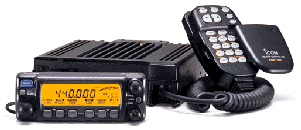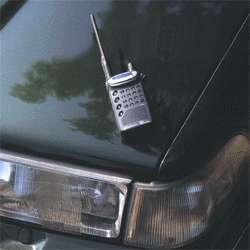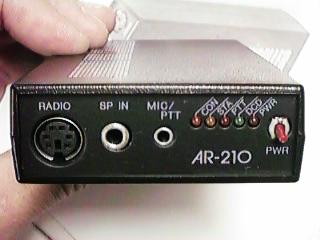KB7YWE's equipment reviews | |
|---|---|
Contents |
Here is a collection of notes and thoughts about various equipment that I own (or have owned). They represent my opinions, but I can always answer questions in more detail if you'd like. |
Ten-Tec Scout 555 HF Transceiver |
|---|

This is my first "new" HF radio, given to me by my wife after I passed my 5WPM code test and becoming a Tech+ license holder. She must have noticed the well worn magazine advertisements, or perhaps I've been talking in my sleep :-)
The Scout is a truly simple, bare-bones radio. It is actually designed as a single-band HF radio, with all band-specific components mounted in a removable module that fits in a slot on the left side of the radio's faceplate. To change bands, you merely pull out the current module and push in the desired module. The idea is that you only need to buy the modules that you need, and that the design effort can be put into making the receiver and transmitter as good as they can be rather than investing in sophisticated band swithcing systems.
Controls are limited and very straightforward. There are switches for power, noise blanker, tune (15W of key-down power), RIT, and keyer speed selection (with speed selected from the paddles). Knobs adjust frequency, AF volume, RIT, SSB ALC, and filter bandwidth (variable "Jones" filter). The only other things on the front are frequency readout LEDs, S/power/SWR meter, mic, and headphone jacks. On the rear of the unit is the power input connector, ground connection, SO-239 antenna connector, straight key jack, paddle jack, and a switch to set the meter to forward power or SWR modes (during transmit).
There are no memories, and with a PTO for tuning it can take a bit of cranking to get from one end of the band to another. Sideband selection for SSB is eliminated as the radio only uses the 'normal' sideband for each band. There really is nothing to learn from the manual, as all operations are quite obvious. I count that as a definite plus.
Output power is 50W, which seems quite adequate to me. I use it with the 11A switching power supply that Ten-Tec offered with the radio.
Back to top
Yaesu FT-817 HF/VHF/UHF QRP Transceiver |
|---|
Back to top
ICOM IC-207 VHF/UHF Mobile |
|---|

I purchased this radio from HRO for use in my VW Camper, particularly since it offered plenty of features with a remote-mountable faceplate. To top it off, Icom offered a free separation cable with purchase when I was shopping for a radio. That saved another $40+ that made the unit very desirable.
Icom has a page about the IC-207H.
The radio is probably best described as a "multi-band" VHF/UHF, rather than a "dual-band", as it does not allow simultaneous operation on both VHF and UHF. There is only a single receiver in the unit, allowing you to receive VHF or UHF, not both at the same time. The display reflects this simplicity as it only displays the current operating frequency, unlike the dual-frequency displays of some other dual-band mobiles (and even some HTs). The unit can operate in a "cross-band" mode (not as a repeater!) where you transmit on 2m and receive on 70cm (for example, to contact a satellite that operates as a cross-band repeater [AO-27]). Output power is rated at 45W on VHF and 35W on UHF.
The remote control microphone is really nice, allowing all functions to be operated from mic buttons. The cover on the microphone can be a bit of a hassle, but it does keep the keys protected, and prevents accidental manipulation of functions. With the cover in place, the most common functions are still available on 7 exposed buttons, two of which are programmable to any of your favorite functions.
The display is extremely clean and easy to read. The buttons below the display line up with "soft" labels on the display. These labels don't change from mode to mode, but I assume it allows Icom to easily customize the unit for other languages. Operation of the unit is very straightforward. Remote mounting of the display is easily accomplished with the remote-mount kit, consisting of a cable that plugs into the radio on one end, and into the display on the other. I merely velcro-ed the display to my dashboard and haven't had any problems at all with it. The main unit is mounted under the driver's seat. Note that the microphone does not connect to the faceplate, so to remote-mount the mic, a second extension cable is needed.
Packet connection is accomplished through a 6-pin mini-din connector (same as used for PS/2 mice and keyboards). This connector includes 1200 and 9600bps ready connections, along with a 'COR' (carrier operated squelch) output. This feature can be used by the Kantronics KPC-3 TNC to detect an incoming signal without depending on a noise squelch or "open squelch DCD" circuit. It also was useful in setting up a temporary frequency-agile repeater for my club -- I used my IC-207H as the receiver, running the audio and COR connections into our repeater controller, while we used a second 2m radio for a transmitter. It worked quite well as an emergency repeater bandage!
Back to top
Standard C510A VHF/UHF HT |
|---|

The radio does not include any batteries. It accepts 3 AA size cells, alkaline or NiCd, or the optional NiCd pack (likely 3 cells in shrink wrap). I chose to use my own batteries, as the only charger available from Standard costs around $89 (in addition to the $30 for the 3 AA NiCds in shrink wrap). The radio does have contacts on the case for use with a drop-in type charger. I found a good alternative to be a set of 4 high-capacity (1100mAh) AA cells, with charger, for $14.79 from PriceCostco. The only problem is figuring out how to deal with the 4th cell, as the charger only charges pairs of cells. I may need to find a way to discharge the single cell so that recharges won't be affected by it.
Rated power is 1W with alkalines, 700mW with NiCds, or 300mW on low power. The optional DC adapter gets the radio to 2.5W, and the optional DC adapter and power booster puts out around 50W. I have not used either of these options, nor have I tested the power out as I don't yet have an SMA to BNC adapter. (Yes, the antenna connecter is the SMA type.)
The speaker/mic connectors on top of the radio (under a rubber plug) are of the 'standard' variety (similar to Icom, Yaesu, etc.), and the unit seems to work nicely with my Radio Shack speaker/mic. There are TNC wiring instructions in the manual, should one desire. The connector on the bottom of the radio for the DC input and RF output to the booster is of a very non-standard type. I would doubt such a connector would be available on the open market.
As far as the user-interface goes, I am as happy as can be. It is quite straightforward (not common among HT vendors, apparently) and I have had no problem programming the memories, tones, DTMF dialer, or what-have-you. My previous radio was a Yaesu FT-530, which I owned for almost 4 years. I am already more comfortable with the standard than I ever was with the Yaesu (but then, it did do everything on the planet). Pretty much every function is set using a simple menu scheme. Push the Set key, then rotate the selector knob until the menu item is displayed. To change the setting, hold in the 'F' key on the side of the radio and turn the selector knob until the proper setting is displayed. Push the Set key to return to normal operation.
The Standard C510A is a dual-band radio, in that it can transmit and receive on the 2m or 440MHz bands. Unlike more advanced dual-banders that have dual receivers, this unit cannot receive more than one band at a time, nor can it cross-band repeat. Odd splits are programmable, but I haven't yet tried a cross-band split (I see no reason why it should not work, though).
The keypad is simple, with no extra labels on the keys to mislead me. The keys are also nicely backlit, with the key labels underneath the clear key buttons, meaning that they cannot rub off with time.
A Quick reference to the C510A functions.
Back to top
Standard C156 VHF HT |
|---|
 I purchased this radio (serial #6YU 040190) directly from Standard Radio
on 18 October 1999,
and intend to use it as a backup transceiver.
I've had my eye on this radio for quite some time, as I really respect
Standard Radio's products, and this radio has a very nice feature set
at a reasonable price. The price was a very important factor in my
purchase decision. Standard is not known as the most frugal choice
in amateur radio products, and even positioned as their entry-level
2m radio, the list price of around $289 was far too high for me. But
on 15 October I received an Amateur Radio Trader magazine (sample
issue) that included an advertisement from Standard Radio offering
the C156A for $99.48. After ordering on Monday, I received the
radio by UPS on Friday, and I'm very pleased with the ammount of
radio I got for my money.
I purchased this radio (serial #6YU 040190) directly from Standard Radio
on 18 October 1999,
and intend to use it as a backup transceiver.
I've had my eye on this radio for quite some time, as I really respect
Standard Radio's products, and this radio has a very nice feature set
at a reasonable price. The price was a very important factor in my
purchase decision. Standard is not known as the most frugal choice
in amateur radio products, and even positioned as their entry-level
2m radio, the list price of around $289 was far too high for me. But
on 15 October I received an Amateur Radio Trader magazine (sample
issue) that included an advertisement from Standard Radio offering
the C156A for $99.48. After ordering on Monday, I received the
radio by UPS on Friday, and I'm very pleased with the ammount of
radio I got for my money.
Similar to the Alinco DJ-190TD, this HT came with a 4-cell alkaline pack so I had to supply my own batteries. I have actually come to like this arrangement, after I purchased my main HT, the Standard C510A. The reason I like it so much is that the batteries have a long shelf life, so when I don't use my HT for a long period of time, the batteries haven't self-discharged by the time I need it. Also, there is no high pack replacement cost, as you just put in new cells and off you go. And if you want to use NiCd batteries (like when you are planning to use the radio a lot during a short period) you can use normal AA rechargeables of any type, and keep a few charged sets handy. You don't have the convenience of drop-in charging, so you have to take the cells out of the pack when they need more juice, but that is a small price to pay.
The radio has many very nice features, including:
The radio has performed well, with good, clear audio, and excellent signal reports. The feel of the radio is very good, with a sturdy cast metal back that fits the hand nicely. This is not a miniature HT, but it is quite small when compared to a Radio Shack HTX-202 or an Icom IC-02AT for example. I found the programming of memories to be very easy, and I didn't have to refer to the manual until I wanted to put a label on the memory. This feature allows you to give a repeater or frequency a name so that it is easier to identify. For example, when I tune to the HPBARC repeater, my display reads "HPBARC" above the frequency. The character set is quite complete, with plenty of Greek and Kanji characters to make things fun.
Standard Radio must have a page about the radio, but their site has been offline for over a week. This, along with the drastic reduction in price of their radios, and the fact that many dealers have stopped advertising Standard products, makes me wonder if Standard Radio is getting out of the amateur business.
Items included in package:
Back to top
Alinco DJ-190TD VHF HT |
|---|
 I purchased this radio (serial #T002631) from TechAmerica on 24 May 1999, and
intend to use it primarily as a portable packet radio transceiver.
The reasons for my choice were: BNC antenna connection, standard mic
and speaker connections (to TNC), and ability to take 13.8VDC input directly
(no convertor or regulator needed). The fact that the radio lacks a
keypad is of no consequence to packet usage, and that it doesn't come
with a NiCd pack is probably a benefit, as the radio will likely sit
idle for long periods of time between uses, leading to NiCd pack death.
I purchased this radio (serial #T002631) from TechAmerica on 24 May 1999, and
intend to use it primarily as a portable packet radio transceiver.
The reasons for my choice were: BNC antenna connection, standard mic
and speaker connections (to TNC), and ability to take 13.8VDC input directly
(no convertor or regulator needed). The fact that the radio lacks a
keypad is of no consequence to packet usage, and that it doesn't come
with a NiCd pack is probably a benefit, as the radio will likely sit
idle for long periods of time between uses, leading to NiCd pack death.
The goal is to set up a compact portable packet station with all devices running from the same 12VDC supply (battery or AC supply), and with the ability to use a higher-gain antenna than the stock rubber duck. This radio suits that goal nicely.
Initial use of the radio for voice contacts has resulted in very good signal reports. Received audio is loud and clear. Even with (or in spite of) the lack of keys, the unit is very easy to program. The display is very clear, and has a nice backlight that can be locked in the 'on' state.
Packet radio usage has also proven to be simple. The squelch and volume controls are 'digital', so you can set them to a particular value and then forget them. This means that the controls are not easy to bump out of position, resulting in more reliable usage. The connections to a KPC-3 TNC are the same as for my other HTs, and the connection to my new AOR AR-210 TNC was even simpler.
My only complaint so far is that the unit doesn't work perfectly on all types of battery. I believe it has to do with the internal resistance of different cells, but the problem shows up as a reset when transmitting in the high-power setting. The first set of alkaline batteries that I used had no problem doing this at all, but the second set did have the problem. It seems to be better with NiCd batteries, and I am using high-capacity cells (1200mAH) at the moment with no problems. This problem does not show up at all when using an external DC source with sufficient current capacity. I was quite surprised to find that the unit draws about 1.65A at 13.8VDC when set to high-power (5W) mode. That's about 22W of input power! A quick survey of other HTs on the market shows that this is not as unusual as I initially thought.
Items included in package (very plain cardboard box):
Back to top
AOR AR-210 TNC |
|---|

What makes this TNC unique is its very small size. The unit measures 11cm x 6cm x 2.5cm, weighs under 100g, and has an optional internal NiCd battery (4.8V 120mAH). I did not purchase the optional battery with the unit ($25). It operates from an external 10 to 13.8VDC supply at 200mA. AX.25 Level2 protocol, Version 1.1.4TE, and TAPR TNC-2 up-load compatible.
Connectors:
Connection to an HT (my Alinco DJ-190TD) was incredibly easy. The unit comes with cables to go from the mini-audio jacks on the HT directly to the mini-audio jacks on the TNC. An internal modification is shown in the manual for Yaesu HTs, which use a different resistor value in the PTT line. It's nice not to have to build a cable to interface the TNC to a radio.
The first PC I tried to connect to was the HP 200LX palmtop. The connectivity kit for the palmtop includes a cable that terminates in a DB-9 female connector for connection to a PC. Also in the kit was a DB-9 male to male gender changer and null modem, and this made connection to the TNC easy. Once again, no special cables were needed. To connect to a desktop PC, a DB-9 male to DB-9 female "straight through" cable works fine, or a null modem cable with the DB-9 gender changer from the palmtop kit.
The unit makes good use of ASICs and surface mount technology. Inside is a Z80A compatible ASIC, TMPZ84C015BF-6 by Toshiba, which does most of the work. There is a small ROM socket for a surface-mount style ROM, and several other surface mount chips soldered to the board. No schematic is included with the manual.
The unit was accompanied by a 3.5" diskette with two simple terminal programs, and an on-line manual of all the commands available to the TNC. The manual can be viewed here.
Back to top
| If this page is missing important information, or something is incorrect, please let me know immediately at [email protected]. |
|---|